Tour Operations Management: Strategic Decisions & Pricing Strategies
VerifiedAdded on 2024/06/11
|23
|5582
|476
Report
AI Summary
This report provides a comprehensive overview of tour operations management, beginning with an assessment of current trends and developments affecting the tour operator industry, including the impact of technology, dynamic packaging, and economic factors like Brexit. It then examines the stages involved in holiday development, from market research and planning to costing, brochure creation, and post-tour management. The report also discusses different methods of contracting for holiday components, such as ad hoc, fixed, and sale-only contracts, and analyzes the roles of various tour operators, including domestic, ground, inbound, and outbound operators. Furthermore, it includes a detailed calculation of holiday selling price using a case study. Finally, strategic and tactical decisions made by tour operators are compared, highlighting the importance of adaptability and consumer-focused approaches in the competitive travel and tourism sector. Desklib offers solved assignments for students.
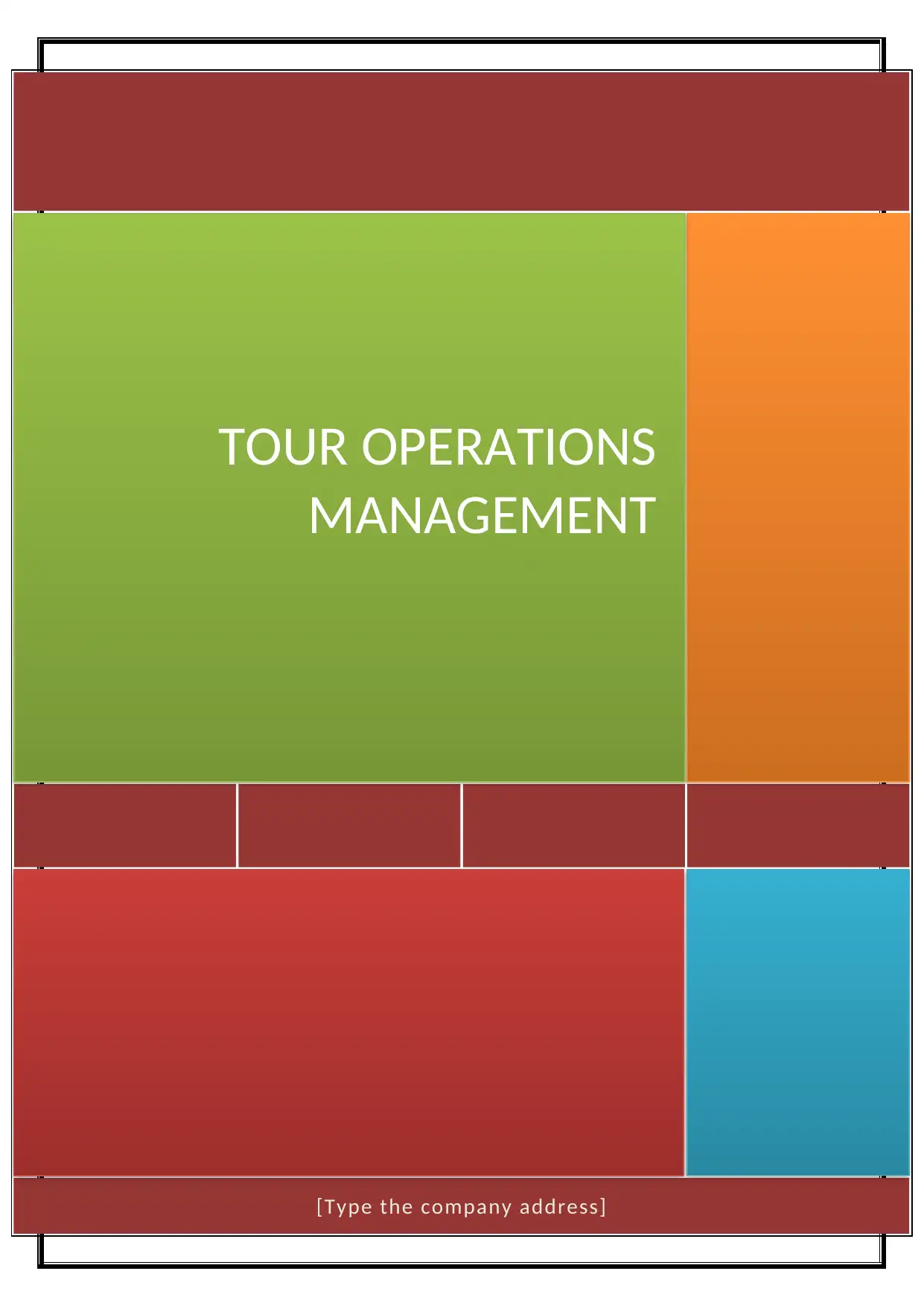
[Type the company address]
TOUR OPERATIONS
MANAGEMENT
TOUR OPERATIONS
MANAGEMENT
Paraphrase This Document
Need a fresh take? Get an instant paraphrase of this document with our AI Paraphraser
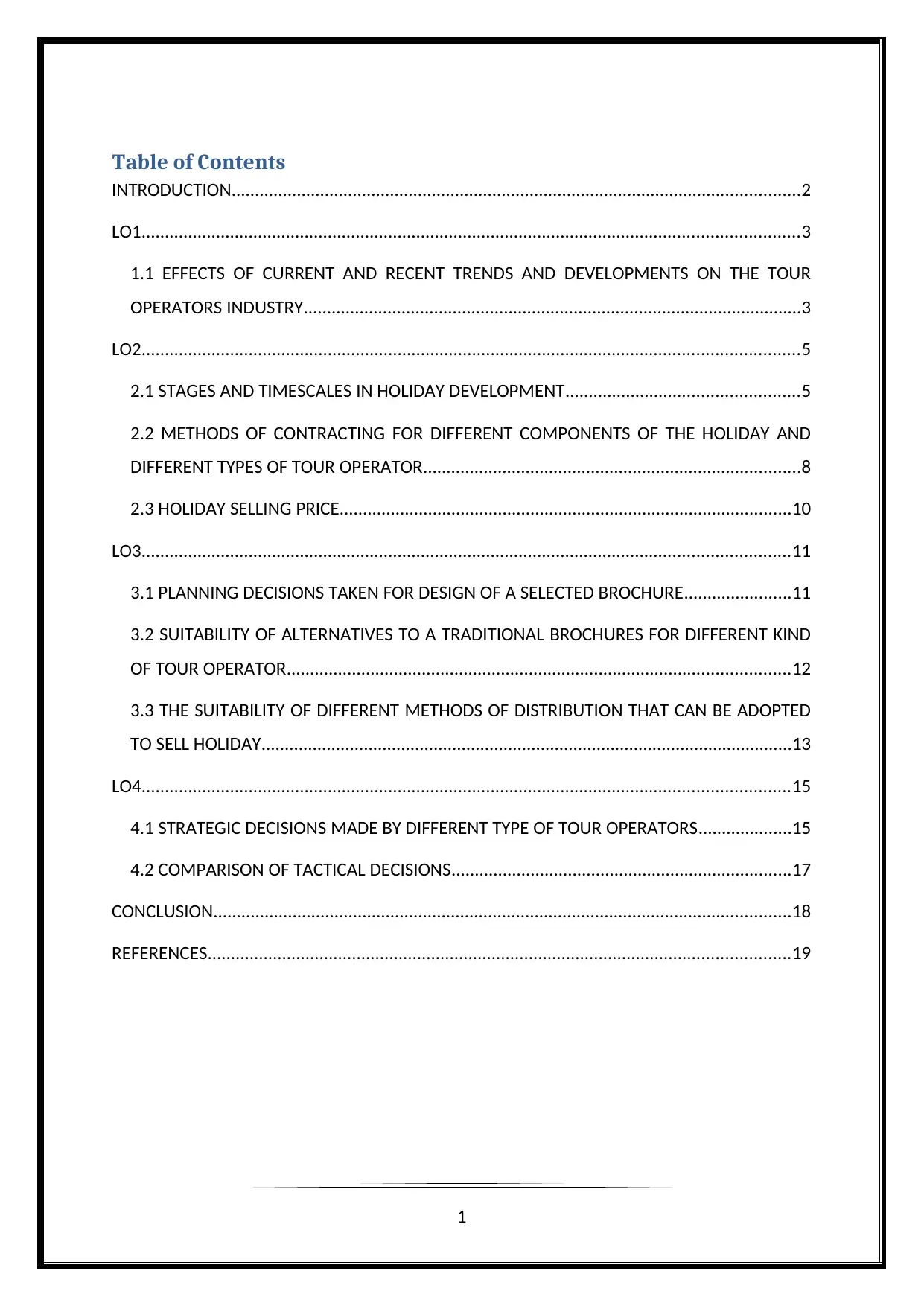
Table of Contents
INTRODUCTION..........................................................................................................................2
LO1.............................................................................................................................................3
1.1 EFFECTS OF CURRENT AND RECENT TRENDS AND DEVELOPMENTS ON THE TOUR
OPERATORS INDUSTRY...........................................................................................................3
LO2.............................................................................................................................................5
2.1 STAGES AND TIMESCALES IN HOLIDAY DEVELOPMENT..................................................5
2.2 METHODS OF CONTRACTING FOR DIFFERENT COMPONENTS OF THE HOLIDAY AND
DIFFERENT TYPES OF TOUR OPERATOR.................................................................................8
2.3 HOLIDAY SELLING PRICE.................................................................................................10
LO3...........................................................................................................................................11
3.1 PLANNING DECISIONS TAKEN FOR DESIGN OF A SELECTED BROCHURE.......................11
3.2 SUITABILITY OF ALTERNATIVES TO A TRADITIONAL BROCHURES FOR DIFFERENT KIND
OF TOUR OPERATOR............................................................................................................12
3.3 THE SUITABILITY OF DIFFERENT METHODS OF DISTRIBUTION THAT CAN BE ADOPTED
TO SELL HOLIDAY..................................................................................................................13
LO4...........................................................................................................................................15
4.1 STRATEGIC DECISIONS MADE BY DIFFERENT TYPE OF TOUR OPERATORS....................15
4.2 COMPARISON OF TACTICAL DECISIONS.........................................................................17
CONCLUSION............................................................................................................................18
REFERENCES.............................................................................................................................19
1
INTRODUCTION..........................................................................................................................2
LO1.............................................................................................................................................3
1.1 EFFECTS OF CURRENT AND RECENT TRENDS AND DEVELOPMENTS ON THE TOUR
OPERATORS INDUSTRY...........................................................................................................3
LO2.............................................................................................................................................5
2.1 STAGES AND TIMESCALES IN HOLIDAY DEVELOPMENT..................................................5
2.2 METHODS OF CONTRACTING FOR DIFFERENT COMPONENTS OF THE HOLIDAY AND
DIFFERENT TYPES OF TOUR OPERATOR.................................................................................8
2.3 HOLIDAY SELLING PRICE.................................................................................................10
LO3...........................................................................................................................................11
3.1 PLANNING DECISIONS TAKEN FOR DESIGN OF A SELECTED BROCHURE.......................11
3.2 SUITABILITY OF ALTERNATIVES TO A TRADITIONAL BROCHURES FOR DIFFERENT KIND
OF TOUR OPERATOR............................................................................................................12
3.3 THE SUITABILITY OF DIFFERENT METHODS OF DISTRIBUTION THAT CAN BE ADOPTED
TO SELL HOLIDAY..................................................................................................................13
LO4...........................................................................................................................................15
4.1 STRATEGIC DECISIONS MADE BY DIFFERENT TYPE OF TOUR OPERATORS....................15
4.2 COMPARISON OF TACTICAL DECISIONS.........................................................................17
CONCLUSION............................................................................................................................18
REFERENCES.............................................................................................................................19
1
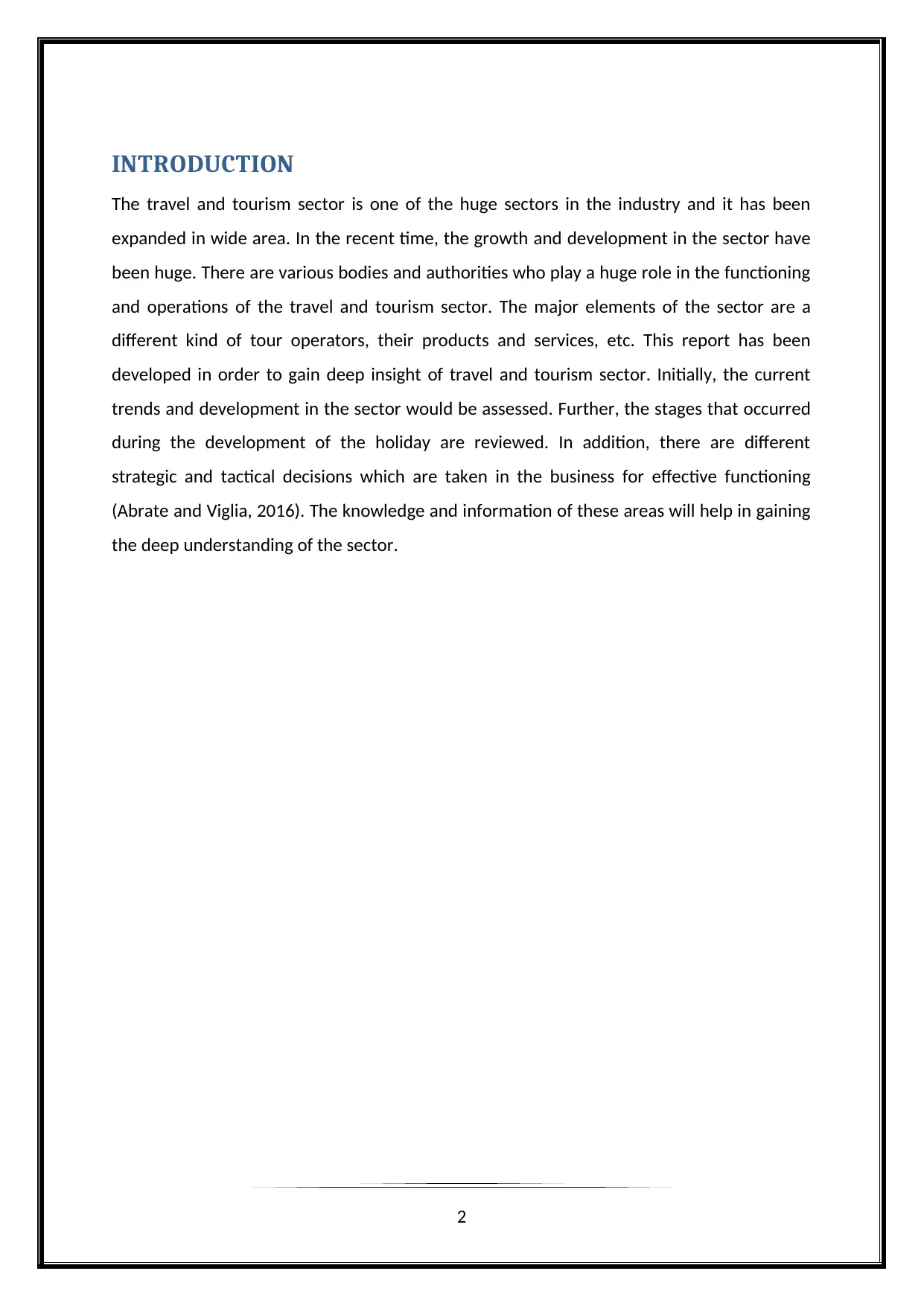
INTRODUCTION
The travel and tourism sector is one of the huge sectors in the industry and it has been
expanded in wide area. In the recent time, the growth and development in the sector have
been huge. There are various bodies and authorities who play a huge role in the functioning
and operations of the travel and tourism sector. The major elements of the sector are a
different kind of tour operators, their products and services, etc. This report has been
developed in order to gain deep insight of travel and tourism sector. Initially, the current
trends and development in the sector would be assessed. Further, the stages that occurred
during the development of the holiday are reviewed. In addition, there are different
strategic and tactical decisions which are taken in the business for effective functioning
(Abrate and Viglia, 2016). The knowledge and information of these areas will help in gaining
the deep understanding of the sector.
2
The travel and tourism sector is one of the huge sectors in the industry and it has been
expanded in wide area. In the recent time, the growth and development in the sector have
been huge. There are various bodies and authorities who play a huge role in the functioning
and operations of the travel and tourism sector. The major elements of the sector are a
different kind of tour operators, their products and services, etc. This report has been
developed in order to gain deep insight of travel and tourism sector. Initially, the current
trends and development in the sector would be assessed. Further, the stages that occurred
during the development of the holiday are reviewed. In addition, there are different
strategic and tactical decisions which are taken in the business for effective functioning
(Abrate and Viglia, 2016). The knowledge and information of these areas will help in gaining
the deep understanding of the sector.
2
⊘ This is a preview!⊘
Do you want full access?
Subscribe today to unlock all pages.

Trusted by 1+ million students worldwide
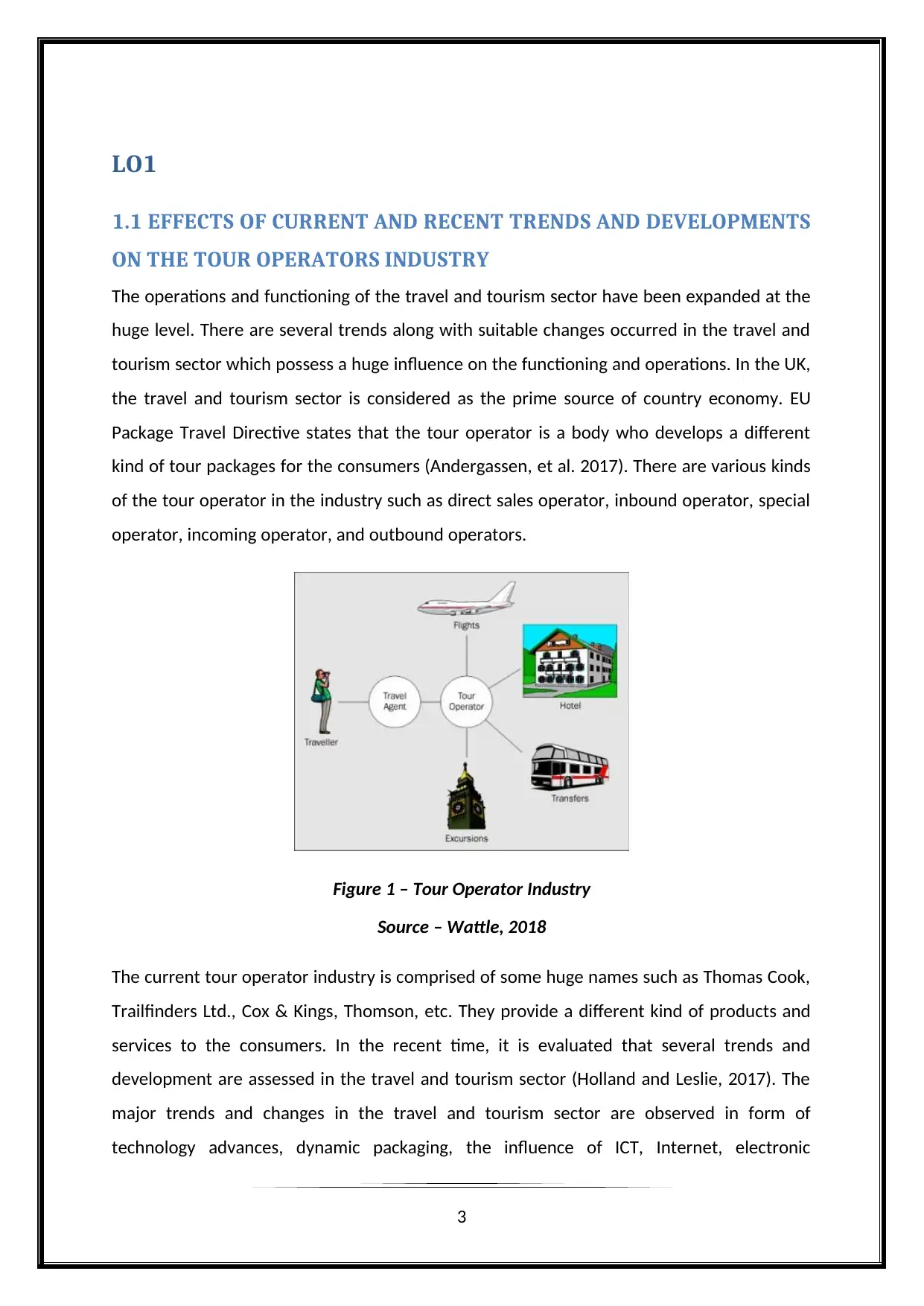
LO1
1.1 EFFECTS OF CURRENT AND RECENT TRENDS AND DEVELOPMENTS
ON THE TOUR OPERATORS INDUSTRY
The operations and functioning of the travel and tourism sector have been expanded at the
huge level. There are several trends along with suitable changes occurred in the travel and
tourism sector which possess a huge influence on the functioning and operations. In the UK,
the travel and tourism sector is considered as the prime source of country economy. EU
Package Travel Directive states that the tour operator is a body who develops a different
kind of tour packages for the consumers (Andergassen, et al. 2017). There are various kinds
of the tour operator in the industry such as direct sales operator, inbound operator, special
operator, incoming operator, and outbound operators.
Figure 1 – Tour Operator Industry
Source – Wattle, 2018
The current tour operator industry is comprised of some huge names such as Thomas Cook,
Trailfinders Ltd., Cox & Kings, Thomson, etc. They provide a different kind of products and
services to the consumers. In the recent time, it is evaluated that several trends and
development are assessed in the travel and tourism sector (Holland and Leslie, 2017). The
major trends and changes in the travel and tourism sector are observed in form of
technology advances, dynamic packaging, the influence of ICT, Internet, electronic
3
1.1 EFFECTS OF CURRENT AND RECENT TRENDS AND DEVELOPMENTS
ON THE TOUR OPERATORS INDUSTRY
The operations and functioning of the travel and tourism sector have been expanded at the
huge level. There are several trends along with suitable changes occurred in the travel and
tourism sector which possess a huge influence on the functioning and operations. In the UK,
the travel and tourism sector is considered as the prime source of country economy. EU
Package Travel Directive states that the tour operator is a body who develops a different
kind of tour packages for the consumers (Andergassen, et al. 2017). There are various kinds
of the tour operator in the industry such as direct sales operator, inbound operator, special
operator, incoming operator, and outbound operators.
Figure 1 – Tour Operator Industry
Source – Wattle, 2018
The current tour operator industry is comprised of some huge names such as Thomas Cook,
Trailfinders Ltd., Cox & Kings, Thomson, etc. They provide a different kind of products and
services to the consumers. In the recent time, it is evaluated that several trends and
development are assessed in the travel and tourism sector (Holland and Leslie, 2017). The
major trends and changes in the travel and tourism sector are observed in form of
technology advances, dynamic packaging, the influence of ICT, Internet, electronic
3
Paraphrase This Document
Need a fresh take? Get an instant paraphrase of this document with our AI Paraphraser
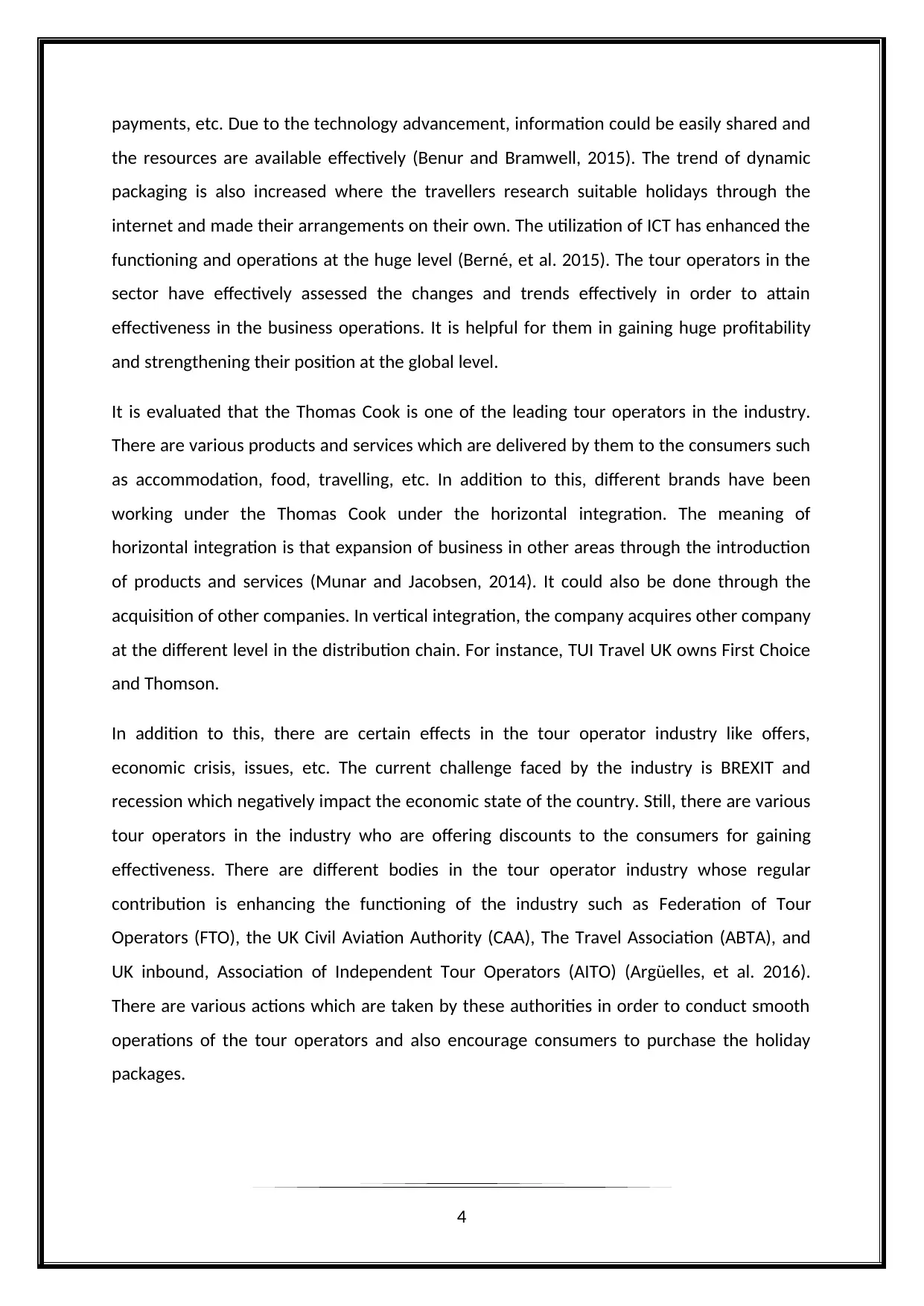
payments, etc. Due to the technology advancement, information could be easily shared and
the resources are available effectively (Benur and Bramwell, 2015). The trend of dynamic
packaging is also increased where the travellers research suitable holidays through the
internet and made their arrangements on their own. The utilization of ICT has enhanced the
functioning and operations at the huge level (Berné, et al. 2015). The tour operators in the
sector have effectively assessed the changes and trends effectively in order to attain
effectiveness in the business operations. It is helpful for them in gaining huge profitability
and strengthening their position at the global level.
It is evaluated that the Thomas Cook is one of the leading tour operators in the industry.
There are various products and services which are delivered by them to the consumers such
as accommodation, food, travelling, etc. In addition to this, different brands have been
working under the Thomas Cook under the horizontal integration. The meaning of
horizontal integration is that expansion of business in other areas through the introduction
of products and services (Munar and Jacobsen, 2014). It could also be done through the
acquisition of other companies. In vertical integration, the company acquires other company
at the different level in the distribution chain. For instance, TUI Travel UK owns First Choice
and Thomson.
In addition to this, there are certain effects in the tour operator industry like offers,
economic crisis, issues, etc. The current challenge faced by the industry is BREXIT and
recession which negatively impact the economic state of the country. Still, there are various
tour operators in the industry who are offering discounts to the consumers for gaining
effectiveness. There are different bodies in the tour operator industry whose regular
contribution is enhancing the functioning of the industry such as Federation of Tour
Operators (FTO), the UK Civil Aviation Authority (CAA), The Travel Association (ABTA), and
UK inbound, Association of Independent Tour Operators (AITO) (Argüelles, et al. 2016).
There are various actions which are taken by these authorities in order to conduct smooth
operations of the tour operators and also encourage consumers to purchase the holiday
packages.
4
the resources are available effectively (Benur and Bramwell, 2015). The trend of dynamic
packaging is also increased where the travellers research suitable holidays through the
internet and made their arrangements on their own. The utilization of ICT has enhanced the
functioning and operations at the huge level (Berné, et al. 2015). The tour operators in the
sector have effectively assessed the changes and trends effectively in order to attain
effectiveness in the business operations. It is helpful for them in gaining huge profitability
and strengthening their position at the global level.
It is evaluated that the Thomas Cook is one of the leading tour operators in the industry.
There are various products and services which are delivered by them to the consumers such
as accommodation, food, travelling, etc. In addition to this, different brands have been
working under the Thomas Cook under the horizontal integration. The meaning of
horizontal integration is that expansion of business in other areas through the introduction
of products and services (Munar and Jacobsen, 2014). It could also be done through the
acquisition of other companies. In vertical integration, the company acquires other company
at the different level in the distribution chain. For instance, TUI Travel UK owns First Choice
and Thomson.
In addition to this, there are certain effects in the tour operator industry like offers,
economic crisis, issues, etc. The current challenge faced by the industry is BREXIT and
recession which negatively impact the economic state of the country. Still, there are various
tour operators in the industry who are offering discounts to the consumers for gaining
effectiveness. There are different bodies in the tour operator industry whose regular
contribution is enhancing the functioning of the industry such as Federation of Tour
Operators (FTO), the UK Civil Aviation Authority (CAA), The Travel Association (ABTA), and
UK inbound, Association of Independent Tour Operators (AITO) (Argüelles, et al. 2016).
There are various actions which are taken by these authorities in order to conduct smooth
operations of the tour operators and also encourage consumers to purchase the holiday
packages.
4
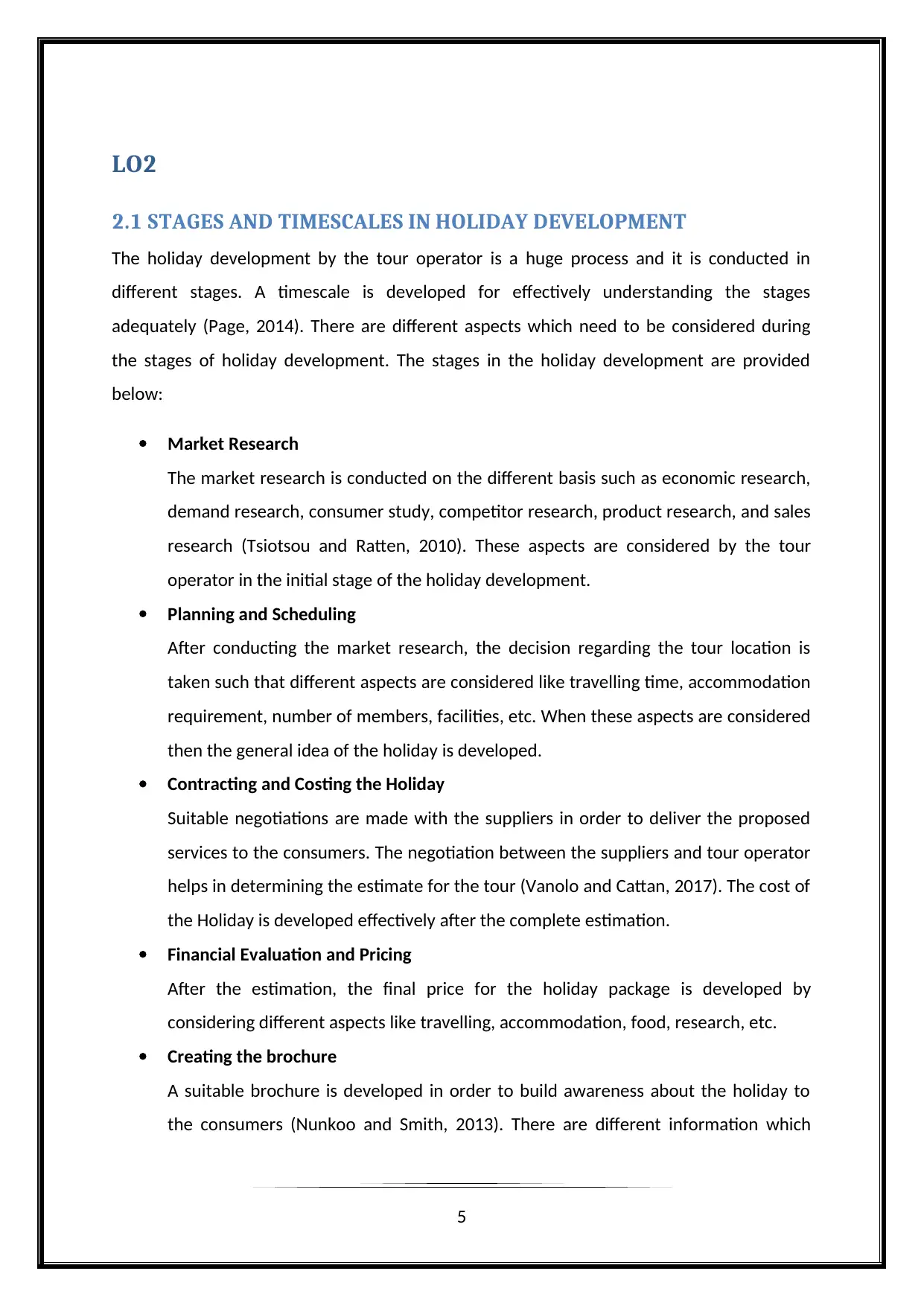
LO2
2.1 STAGES AND TIMESCALES IN HOLIDAY DEVELOPMENT
The holiday development by the tour operator is a huge process and it is conducted in
different stages. A timescale is developed for effectively understanding the stages
adequately (Page, 2014). There are different aspects which need to be considered during
the stages of holiday development. The stages in the holiday development are provided
below:
Market Research
The market research is conducted on the different basis such as economic research,
demand research, consumer study, competitor research, product research, and sales
research (Tsiotsou and Ratten, 2010). These aspects are considered by the tour
operator in the initial stage of the holiday development.
Planning and Scheduling
After conducting the market research, the decision regarding the tour location is
taken such that different aspects are considered like travelling time, accommodation
requirement, number of members, facilities, etc. When these aspects are considered
then the general idea of the holiday is developed.
Contracting and Costing the Holiday
Suitable negotiations are made with the suppliers in order to deliver the proposed
services to the consumers. The negotiation between the suppliers and tour operator
helps in determining the estimate for the tour (Vanolo and Cattan, 2017). The cost of
the Holiday is developed effectively after the complete estimation.
Financial Evaluation and Pricing
After the estimation, the final price for the holiday package is developed by
considering different aspects like travelling, accommodation, food, research, etc.
Creating the brochure
A suitable brochure is developed in order to build awareness about the holiday to
the consumers (Nunkoo and Smith, 2013). There are different information which
5
2.1 STAGES AND TIMESCALES IN HOLIDAY DEVELOPMENT
The holiday development by the tour operator is a huge process and it is conducted in
different stages. A timescale is developed for effectively understanding the stages
adequately (Page, 2014). There are different aspects which need to be considered during
the stages of holiday development. The stages in the holiday development are provided
below:
Market Research
The market research is conducted on the different basis such as economic research,
demand research, consumer study, competitor research, product research, and sales
research (Tsiotsou and Ratten, 2010). These aspects are considered by the tour
operator in the initial stage of the holiday development.
Planning and Scheduling
After conducting the market research, the decision regarding the tour location is
taken such that different aspects are considered like travelling time, accommodation
requirement, number of members, facilities, etc. When these aspects are considered
then the general idea of the holiday is developed.
Contracting and Costing the Holiday
Suitable negotiations are made with the suppliers in order to deliver the proposed
services to the consumers. The negotiation between the suppliers and tour operator
helps in determining the estimate for the tour (Vanolo and Cattan, 2017). The cost of
the Holiday is developed effectively after the complete estimation.
Financial Evaluation and Pricing
After the estimation, the final price for the holiday package is developed by
considering different aspects like travelling, accommodation, food, research, etc.
Creating the brochure
A suitable brochure is developed in order to build awareness about the holiday to
the consumers (Nunkoo and Smith, 2013). There are different information which
5
⊘ This is a preview!⊘
Do you want full access?
Subscribe today to unlock all pages.

Trusted by 1+ million students worldwide
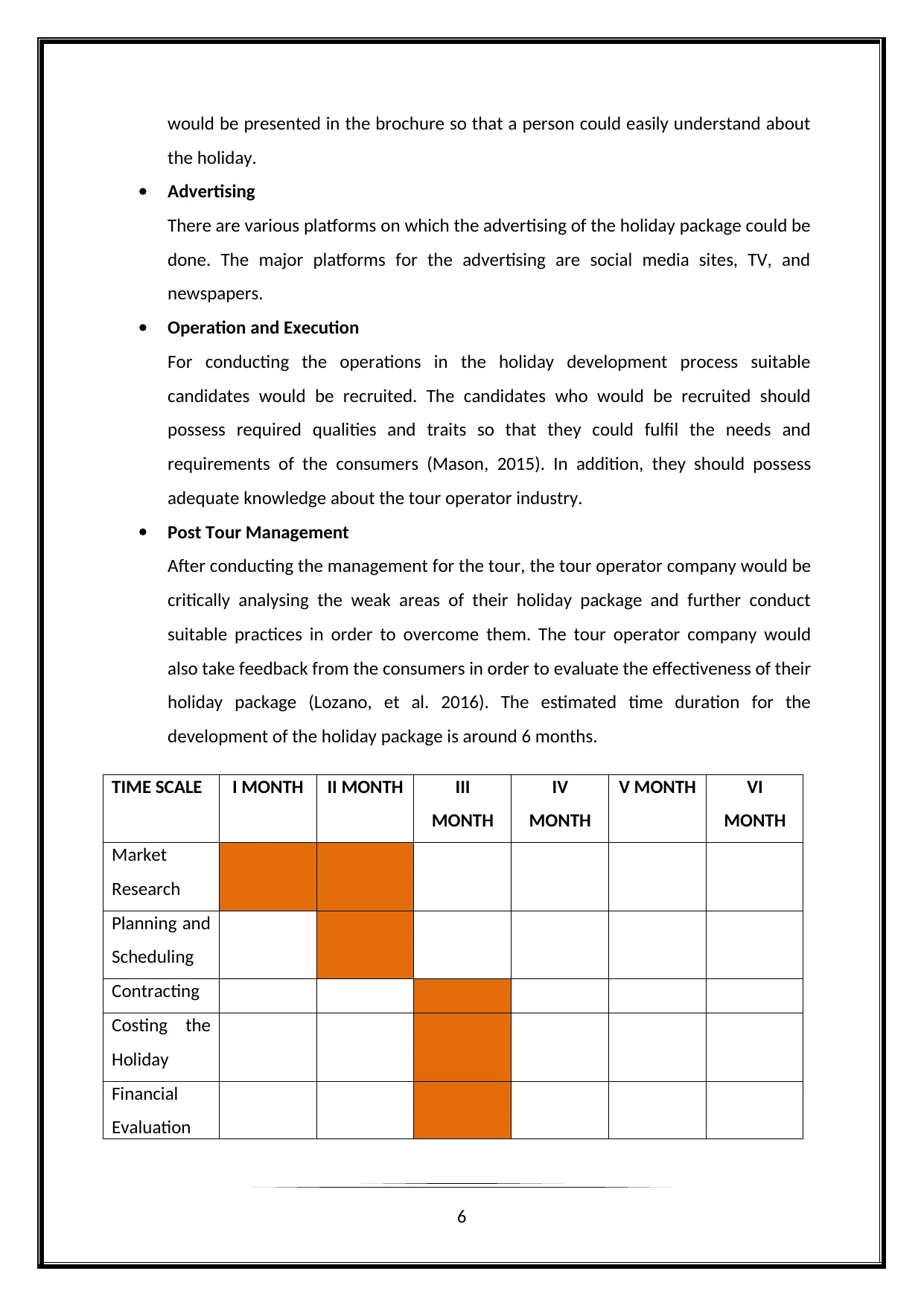
would be presented in the brochure so that a person could easily understand about
the holiday.
Advertising
There are various platforms on which the advertising of the holiday package could be
done. The major platforms for the advertising are social media sites, TV, and
newspapers.
Operation and Execution
For conducting the operations in the holiday development process suitable
candidates would be recruited. The candidates who would be recruited should
possess required qualities and traits so that they could fulfil the needs and
requirements of the consumers (Mason, 2015). In addition, they should possess
adequate knowledge about the tour operator industry.
Post Tour Management
After conducting the management for the tour, the tour operator company would be
critically analysing the weak areas of their holiday package and further conduct
suitable practices in order to overcome them. The tour operator company would
also take feedback from the consumers in order to evaluate the effectiveness of their
holiday package (Lozano, et al. 2016). The estimated time duration for the
development of the holiday package is around 6 months.
TIME SCALE I MONTH II MONTH III
MONTH
IV
MONTH
V MONTH VI
MONTH
Market
Research
Planning and
Scheduling
Contracting
Costing the
Holiday
Financial
Evaluation
6
the holiday.
Advertising
There are various platforms on which the advertising of the holiday package could be
done. The major platforms for the advertising are social media sites, TV, and
newspapers.
Operation and Execution
For conducting the operations in the holiday development process suitable
candidates would be recruited. The candidates who would be recruited should
possess required qualities and traits so that they could fulfil the needs and
requirements of the consumers (Mason, 2015). In addition, they should possess
adequate knowledge about the tour operator industry.
Post Tour Management
After conducting the management for the tour, the tour operator company would be
critically analysing the weak areas of their holiday package and further conduct
suitable practices in order to overcome them. The tour operator company would
also take feedback from the consumers in order to evaluate the effectiveness of their
holiday package (Lozano, et al. 2016). The estimated time duration for the
development of the holiday package is around 6 months.
TIME SCALE I MONTH II MONTH III
MONTH
IV
MONTH
V MONTH VI
MONTH
Market
Research
Planning and
Scheduling
Contracting
Costing the
Holiday
Financial
Evaluation
6
Paraphrase This Document
Need a fresh take? Get an instant paraphrase of this document with our AI Paraphraser
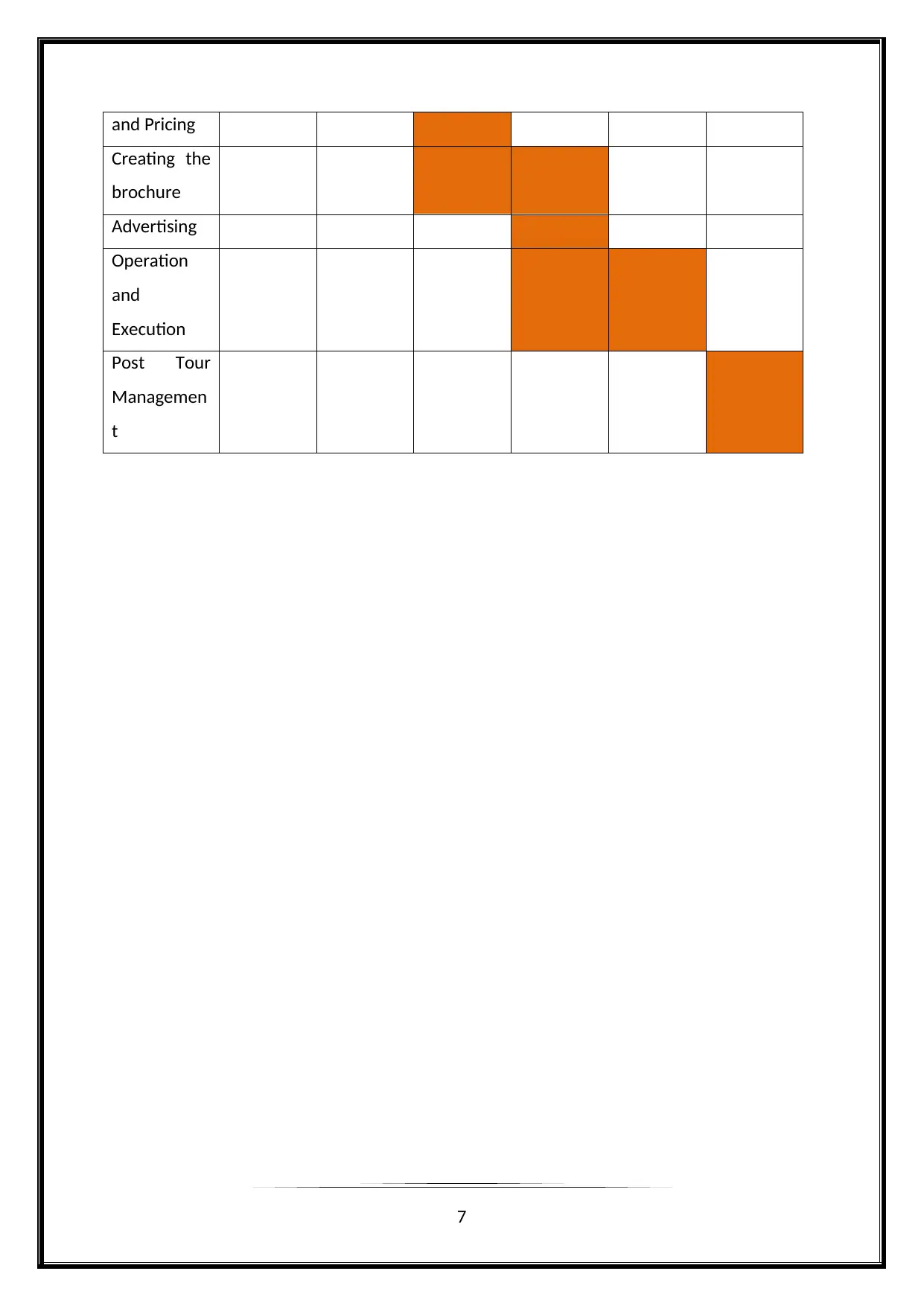
and Pricing
Creating the
brochure
Advertising
Operation
and
Execution
Post Tour
Managemen
t
7
Creating the
brochure
Advertising
Operation
and
Execution
Post Tour
Managemen
t
7
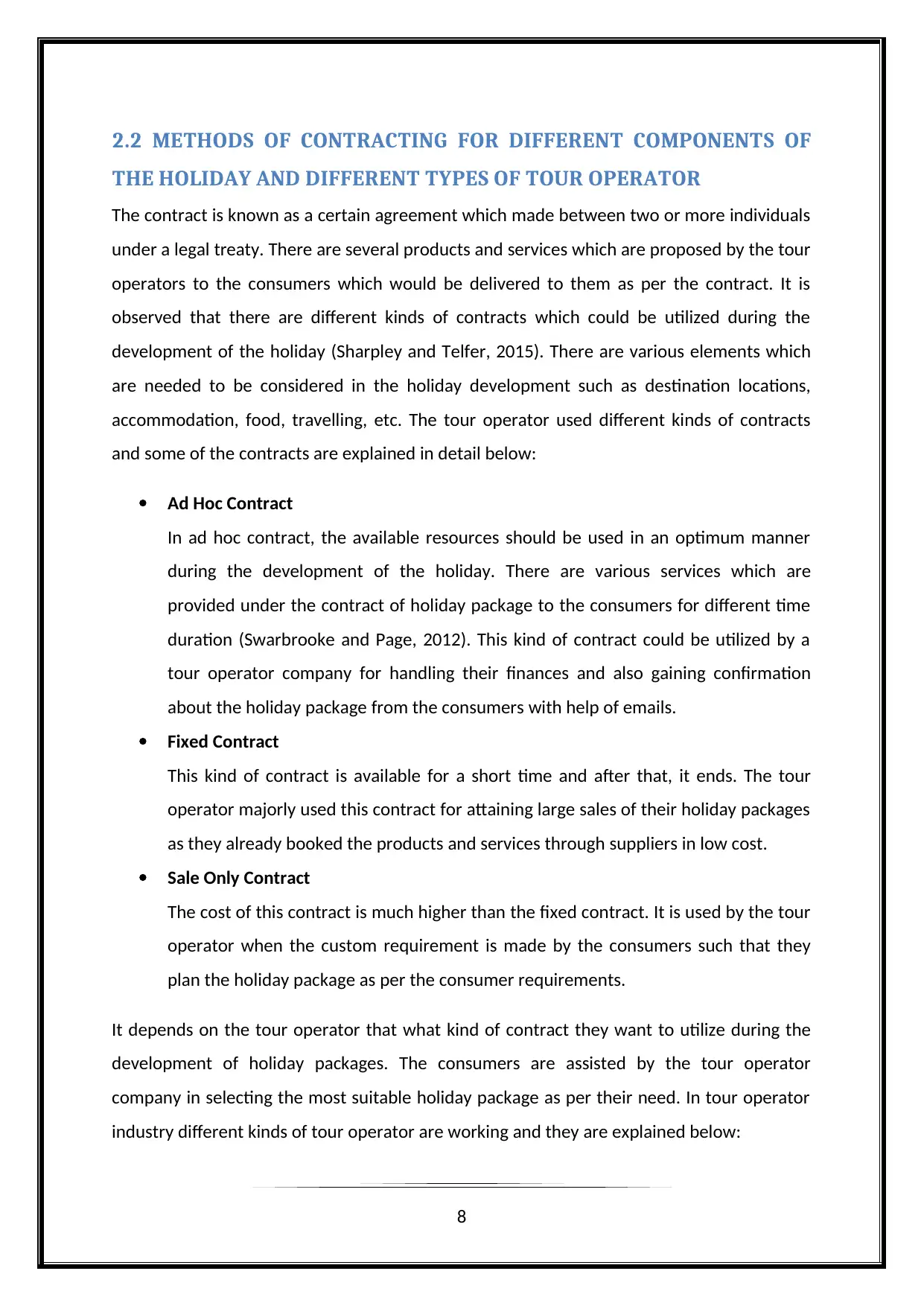
2.2 METHODS OF CONTRACTING FOR DIFFERENT COMPONENTS OF
THE HOLIDAY AND DIFFERENT TYPES OF TOUR OPERATOR
The contract is known as a certain agreement which made between two or more individuals
under a legal treaty. There are several products and services which are proposed by the tour
operators to the consumers which would be delivered to them as per the contract. It is
observed that there are different kinds of contracts which could be utilized during the
development of the holiday (Sharpley and Telfer, 2015). There are various elements which
are needed to be considered in the holiday development such as destination locations,
accommodation, food, travelling, etc. The tour operator used different kinds of contracts
and some of the contracts are explained in detail below:
Ad Hoc Contract
In ad hoc contract, the available resources should be used in an optimum manner
during the development of the holiday. There are various services which are
provided under the contract of holiday package to the consumers for different time
duration (Swarbrooke and Page, 2012). This kind of contract could be utilized by a
tour operator company for handling their finances and also gaining confirmation
about the holiday package from the consumers with help of emails.
Fixed Contract
This kind of contract is available for a short time and after that, it ends. The tour
operator majorly used this contract for attaining large sales of their holiday packages
as they already booked the products and services through suppliers in low cost.
Sale Only Contract
The cost of this contract is much higher than the fixed contract. It is used by the tour
operator when the custom requirement is made by the consumers such that they
plan the holiday package as per the consumer requirements.
It depends on the tour operator that what kind of contract they want to utilize during the
development of holiday packages. The consumers are assisted by the tour operator
company in selecting the most suitable holiday package as per their need. In tour operator
industry different kinds of tour operator are working and they are explained below:
8
THE HOLIDAY AND DIFFERENT TYPES OF TOUR OPERATOR
The contract is known as a certain agreement which made between two or more individuals
under a legal treaty. There are several products and services which are proposed by the tour
operators to the consumers which would be delivered to them as per the contract. It is
observed that there are different kinds of contracts which could be utilized during the
development of the holiday (Sharpley and Telfer, 2015). There are various elements which
are needed to be considered in the holiday development such as destination locations,
accommodation, food, travelling, etc. The tour operator used different kinds of contracts
and some of the contracts are explained in detail below:
Ad Hoc Contract
In ad hoc contract, the available resources should be used in an optimum manner
during the development of the holiday. There are various services which are
provided under the contract of holiday package to the consumers for different time
duration (Swarbrooke and Page, 2012). This kind of contract could be utilized by a
tour operator company for handling their finances and also gaining confirmation
about the holiday package from the consumers with help of emails.
Fixed Contract
This kind of contract is available for a short time and after that, it ends. The tour
operator majorly used this contract for attaining large sales of their holiday packages
as they already booked the products and services through suppliers in low cost.
Sale Only Contract
The cost of this contract is much higher than the fixed contract. It is used by the tour
operator when the custom requirement is made by the consumers such that they
plan the holiday package as per the consumer requirements.
It depends on the tour operator that what kind of contract they want to utilize during the
development of holiday packages. The consumers are assisted by the tour operator
company in selecting the most suitable holiday package as per their need. In tour operator
industry different kinds of tour operator are working and they are explained below:
8
⊘ This is a preview!⊘
Do you want full access?
Subscribe today to unlock all pages.

Trusted by 1+ million students worldwide
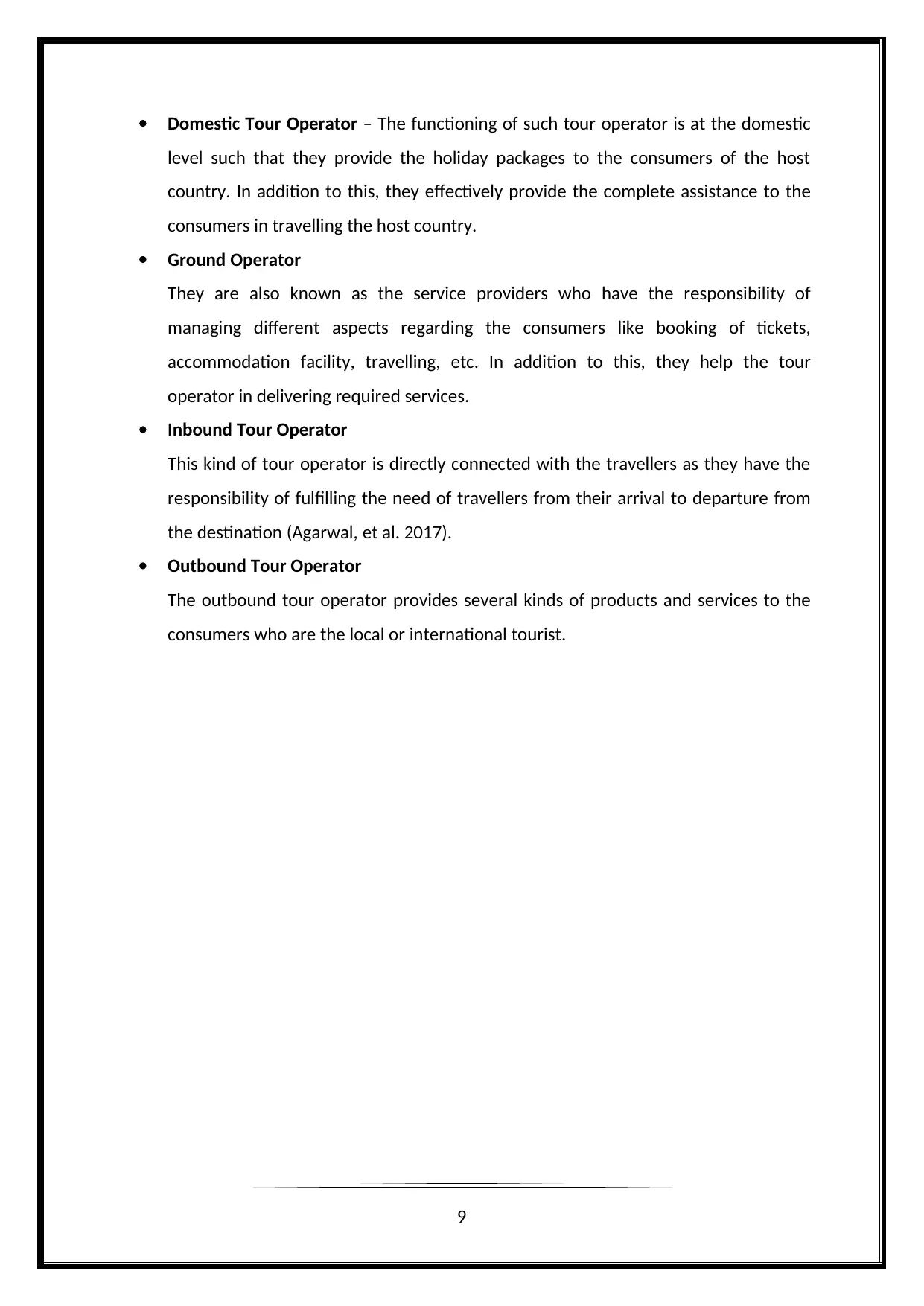
Domestic Tour Operator – The functioning of such tour operator is at the domestic
level such that they provide the holiday packages to the consumers of the host
country. In addition to this, they effectively provide the complete assistance to the
consumers in travelling the host country.
Ground Operator
They are also known as the service providers who have the responsibility of
managing different aspects regarding the consumers like booking of tickets,
accommodation facility, travelling, etc. In addition to this, they help the tour
operator in delivering required services.
Inbound Tour Operator
This kind of tour operator is directly connected with the travellers as they have the
responsibility of fulfilling the need of travellers from their arrival to departure from
the destination (Agarwal, et al. 2017).
Outbound Tour Operator
The outbound tour operator provides several kinds of products and services to the
consumers who are the local or international tourist.
9
level such that they provide the holiday packages to the consumers of the host
country. In addition to this, they effectively provide the complete assistance to the
consumers in travelling the host country.
Ground Operator
They are also known as the service providers who have the responsibility of
managing different aspects regarding the consumers like booking of tickets,
accommodation facility, travelling, etc. In addition to this, they help the tour
operator in delivering required services.
Inbound Tour Operator
This kind of tour operator is directly connected with the travellers as they have the
responsibility of fulfilling the need of travellers from their arrival to departure from
the destination (Agarwal, et al. 2017).
Outbound Tour Operator
The outbound tour operator provides several kinds of products and services to the
consumers who are the local or international tourist.
9
Paraphrase This Document
Need a fresh take? Get an instant paraphrase of this document with our AI Paraphraser
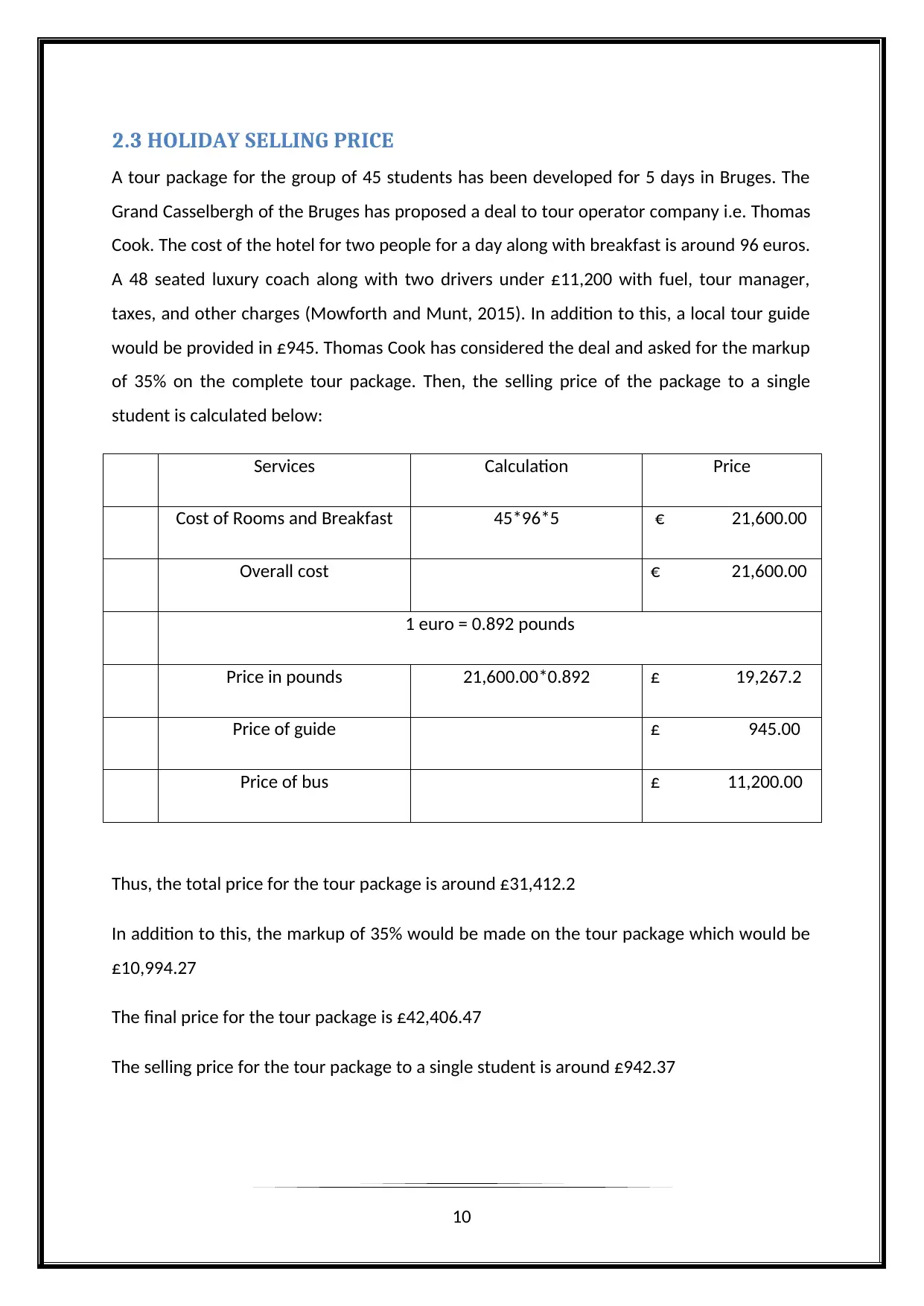
2.3 HOLIDAY SELLING PRICE
A tour package for the group of 45 students has been developed for 5 days in Bruges. The
Grand Casselbergh of the Bruges has proposed a deal to tour operator company i.e. Thomas
Cook. The cost of the hotel for two people for a day along with breakfast is around 96 euros.
A 48 seated luxury coach along with two drivers under £11,200 with fuel, tour manager,
taxes, and other charges (Mowforth and Munt, 2015). In addition to this, a local tour guide
would be provided in £945. Thomas Cook has considered the deal and asked for the markup
of 35% on the complete tour package. Then, the selling price of the package to a single
student is calculated below:
Services Calculation Price
Cost of Rooms and Breakfast 45*96*5 € 21,600.00
Overall cost € 21,600.00
1 euro = 0.892 pounds
Price in pounds 21,600.00*0.892 £ 19,267.2
Price of guide £ 945.00
Price of bus £ 11,200.00
Thus, the total price for the tour package is around £31,412.2
In addition to this, the markup of 35% would be made on the tour package which would be
£10,994.27
The final price for the tour package is £42,406.47
The selling price for the tour package to a single student is around £942.37
10
A tour package for the group of 45 students has been developed for 5 days in Bruges. The
Grand Casselbergh of the Bruges has proposed a deal to tour operator company i.e. Thomas
Cook. The cost of the hotel for two people for a day along with breakfast is around 96 euros.
A 48 seated luxury coach along with two drivers under £11,200 with fuel, tour manager,
taxes, and other charges (Mowforth and Munt, 2015). In addition to this, a local tour guide
would be provided in £945. Thomas Cook has considered the deal and asked for the markup
of 35% on the complete tour package. Then, the selling price of the package to a single
student is calculated below:
Services Calculation Price
Cost of Rooms and Breakfast 45*96*5 € 21,600.00
Overall cost € 21,600.00
1 euro = 0.892 pounds
Price in pounds 21,600.00*0.892 £ 19,267.2
Price of guide £ 945.00
Price of bus £ 11,200.00
Thus, the total price for the tour package is around £31,412.2
In addition to this, the markup of 35% would be made on the tour package which would be
£10,994.27
The final price for the tour package is £42,406.47
The selling price for the tour package to a single student is around £942.37
10
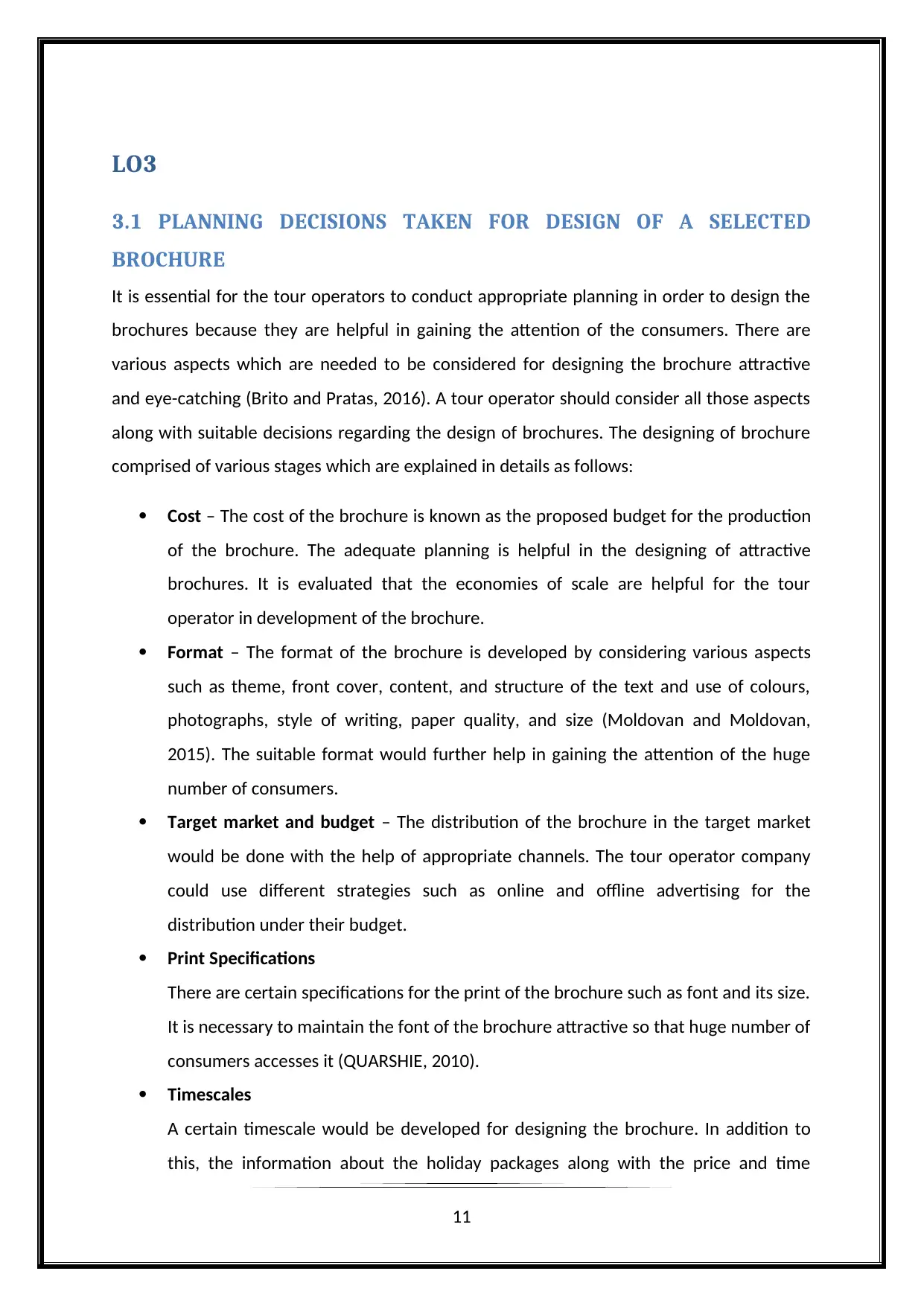
LO3
3.1 PLANNING DECISIONS TAKEN FOR DESIGN OF A SELECTED
BROCHURE
It is essential for the tour operators to conduct appropriate planning in order to design the
brochures because they are helpful in gaining the attention of the consumers. There are
various aspects which are needed to be considered for designing the brochure attractive
and eye-catching (Brito and Pratas, 2016). A tour operator should consider all those aspects
along with suitable decisions regarding the design of brochures. The designing of brochure
comprised of various stages which are explained in details as follows:
Cost – The cost of the brochure is known as the proposed budget for the production
of the brochure. The adequate planning is helpful in the designing of attractive
brochures. It is evaluated that the economies of scale are helpful for the tour
operator in development of the brochure.
Format – The format of the brochure is developed by considering various aspects
such as theme, front cover, content, and structure of the text and use of colours,
photographs, style of writing, paper quality, and size (Moldovan and Moldovan,
2015). The suitable format would further help in gaining the attention of the huge
number of consumers.
Target market and budget – The distribution of the brochure in the target market
would be done with the help of appropriate channels. The tour operator company
could use different strategies such as online and offline advertising for the
distribution under their budget.
Print Specifications
There are certain specifications for the print of the brochure such as font and its size.
It is necessary to maintain the font of the brochure attractive so that huge number of
consumers accesses it (QUARSHIE, 2010).
Timescales
A certain timescale would be developed for designing the brochure. In addition to
this, the information about the holiday packages along with the price and time
11
3.1 PLANNING DECISIONS TAKEN FOR DESIGN OF A SELECTED
BROCHURE
It is essential for the tour operators to conduct appropriate planning in order to design the
brochures because they are helpful in gaining the attention of the consumers. There are
various aspects which are needed to be considered for designing the brochure attractive
and eye-catching (Brito and Pratas, 2016). A tour operator should consider all those aspects
along with suitable decisions regarding the design of brochures. The designing of brochure
comprised of various stages which are explained in details as follows:
Cost – The cost of the brochure is known as the proposed budget for the production
of the brochure. The adequate planning is helpful in the designing of attractive
brochures. It is evaluated that the economies of scale are helpful for the tour
operator in development of the brochure.
Format – The format of the brochure is developed by considering various aspects
such as theme, front cover, content, and structure of the text and use of colours,
photographs, style of writing, paper quality, and size (Moldovan and Moldovan,
2015). The suitable format would further help in gaining the attention of the huge
number of consumers.
Target market and budget – The distribution of the brochure in the target market
would be done with the help of appropriate channels. The tour operator company
could use different strategies such as online and offline advertising for the
distribution under their budget.
Print Specifications
There are certain specifications for the print of the brochure such as font and its size.
It is necessary to maintain the font of the brochure attractive so that huge number of
consumers accesses it (QUARSHIE, 2010).
Timescales
A certain timescale would be developed for designing the brochure. In addition to
this, the information about the holiday packages along with the price and time
11
⊘ This is a preview!⊘
Do you want full access?
Subscribe today to unlock all pages.

Trusted by 1+ million students worldwide
1 out of 23
Related Documents
Your All-in-One AI-Powered Toolkit for Academic Success.
+13062052269
info@desklib.com
Available 24*7 on WhatsApp / Email
![[object Object]](/_next/static/media/star-bottom.7253800d.svg)
Unlock your academic potential
Copyright © 2020–2025 A2Z Services. All Rights Reserved. Developed and managed by ZUCOL.





